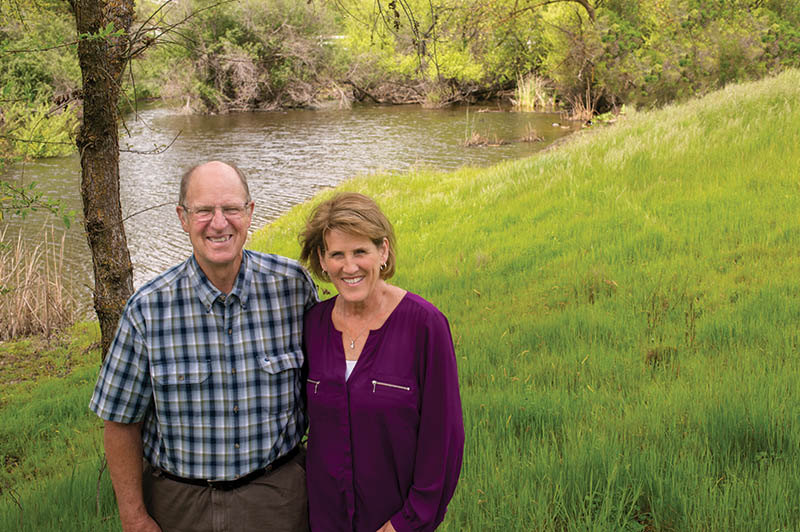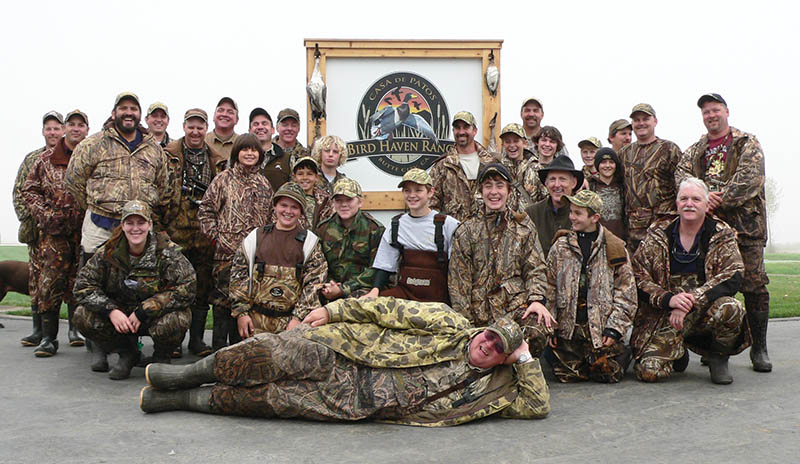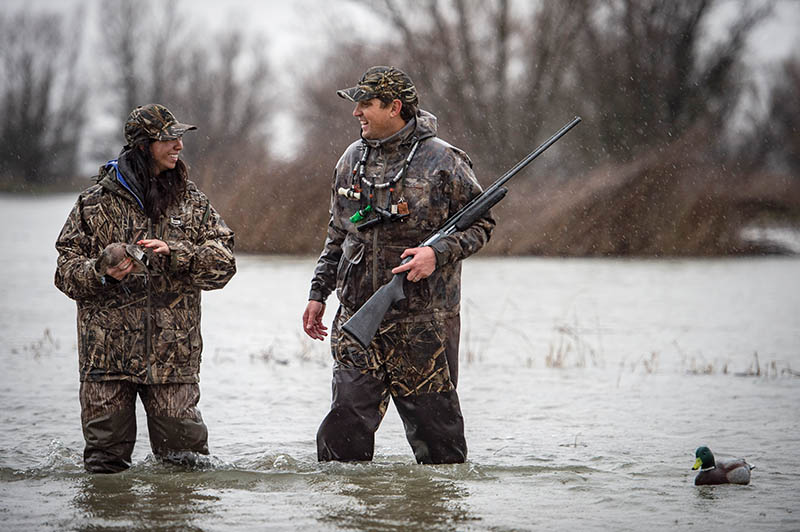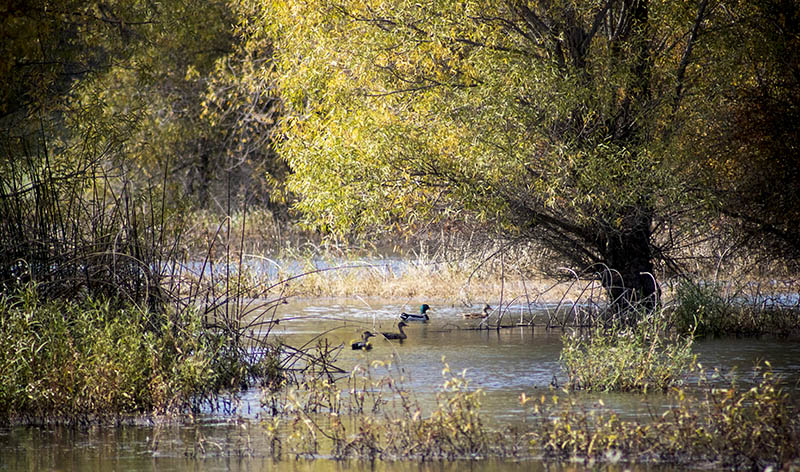
May 29, 2019
Bondersons make it happen

by HOLLY A. HEYSER, EDITOR
We were refuge rats.
These are not words you expect to come out of a multi-millionaire’s mouth. But Paul Bonderson was still hunting at the refuges even after the tech company he co-founded— Brocade Communications Systems—went public on his birthday in 1999 and made him a fortune.
At least he was a refuge rat, until one bad day at the Delevan National Wildlife Refuge. Paul went to the refuge that day with his brother-in-law Dennis Hulse and nephew Tyson because one of them had gotten a good reservation. They found a nice little spot in free roam, put out decoys and waited for shoot time.
Then, 30 minutes before shoot time, that guy showed up. You know, the guy who sets up 50 yards from you, cusses you out for being in “his” spot and drops F-bombs in front of a 12-year-old.
Shoot time came and someone in their party killed a duck, and suddenly they were surrounded by even more hunters with no sense of personal space.
“I looked over at Dennis and said, ‘It’s time to buy a duck club.’” That was the spark that led to the creation of Bird Haven Ranch. In 2001, Paul bought a 640-acre rice farm along Howard Slough in the Upper Butte Basin and put California Waterfowl to work restoring it, creating a lush wetland paradise that looks as old as time.
For a wealthy man to retreat from the aggravations of public-land hunting is pretty much a no-brainer. If it hadn’t been the experience at Delevan, a dozen other things could have made him take the plunge. And really, who wouldn’t do the same?
It was what he and his wife Sandi did when the restoration and lodge was complete that is remarkable: They started sharing Bird Haven. A lot.
Skip to:
What is Bird Haven?
How Paul and Sandi met
What is Brocade?
ONE THING LEADS TO ANOTHER
Paul and Sandi’s immersion in philanthropy began very quickly after Brocade went public, and in 2001, they decided to focus their giving on at-risk youth, higher education and conservation. Their first beneficiaries were Ducks Unlimited, the Taylor Family Foundation and Cal Poly San Luis Obispo—Paul’s alma mater.
But Paul began reaching out to the UC Davis Department of Wildlife, Fish & Conservation Biology to learn more about creating effective waterfowl brood ponds, and ended up getting more and more involved with Davis, too. He joined the Dean’s Advisory Council for the College of Agricultural and Environmental Sciences at UC Davis, and made a major donation to its Raveling Endowed Waterfowl Chair fund.
And he was working with CWA on a day-to-day basis, with Jake Messerli—then fresh out of college, now the organization’s chief operating officer—designing and overseeing the Bird Haven restoration.
These relationships laid the groundwork for some incredible developments. George Oberstadt came to work for California Waterfowl in 2007, and one of the first things he did was write six proposals to hold weekend youth camps at duck clubs where kids could complete hunter education and learn hunting and shooting skills.
“They all said yes,” said Oberstadt, now hunter education coordinator for the state of Wyoming, “but the thing that made Paul and Sandi stand out was the proposal for them was for a weekend during hunting season.”
The ability to go hunting immediately after passing hunter ed is a big deal on its own, but going on that hunt at the legendary Bird Haven Ranch made this a premium opportunity.
To top it off, once camp was in session, Oberstadt found the Bondersons to be hands-on and easy-going. "Paul and Sandi are there every step of the way, helping out, flipping burgers, getting breakfast ready,” he said.
“When you go to somebody’s beautiful duck club, you’re a little bit uneasy. You’re walking on eggshells,” he said. “But at Bird Haven, you never had the sense that you were imposing.”
Quite the opposite: The Bondersons treated him like family, and Paul was always offering to do more. “Can you imagine Paul Bonderson working for you, asking, ‘What else can we do to help?’” Oberstadt said. “It was kind of surreal.”
“I have been a professional in the conservation world for over 30 years and I have never met anyone like Paul and Sandi. Their unique combination of generosity, enthusiasm and volunteerism are all delivered in a truly salt-of-the-earth way, and I will always be grateful to know and work with them!”
—John Carlson, Jr., president of California Waterfowl

Paul Bonderson, front, poses with youth campers after a hunt at Bird Haven Ranch.
Paul said that’s just how he and Sandi were raised.
“We’re no different than anybody else,” Sandi said. Yes, they’re wealthy. But, she said, “I don’t think our personalities have changed since Brocade went public.”
The youth camp, still held each year in November, remains one of Paul’s favorite events at Bird Haven. And the hunting that he personally gives up for it is utterly insignificant when held up against the joy he sees on kids’ faces when they show him their first ducks, or when they approach him at dinners a decade later and say, “Mr. Bonderson, I went on my first hunt at Bird Haven!”
AND NOW FOR SOMETHING REVOLUTIONARY
A year or so after starting Youth Camp, Paul was talking with John Eadie, the Raveling Waterfowl Chair at UC Davis, and Bob McLandress, who was president of CWA at the time and is now associate faculty at Davis. Paul started asking big questions.
“What are your dreams? What are your visions?” Eadie recalls him asking.
Eadie told him about a growing problem in the college, and his wishful-thinking solution.
The Davis wildlife biology program trained students who would become habitat and wildlife managers, working closely with the hunters who both fund conservation and actively use the resource. In the old days, most of the students came from rural areas and had hunting backgrounds. But now they were increasingly coming from urban areas and not only lacked hunting backgrounds, but often lacked any meaningful connection to wildlife whatsoever. This did not bode well.
Back at the University of Wisconsin– Madison, the late goose biologist Don Rusch had created a class where students just like this could spend a quarter learning about shooting, hunting, game cooking and even decoy carving.
But that was in Wisconsin, which is a very hunting-friendly state, and Eadie was working in ultra-liberal Davis. “We’re never going to pull it off at UC Davis,” he told Paul.
Paul responded: “Let’s just make it happen!”
So they called George Oberstadt and College Camp was born in 2009—a three-day program offered by Bird Haven and California Waterfowl for UC Davis wildlife students (Delta Waterfowl now has a similar program that operates nationwide).

Jake Messerli, chief operating officer at CWA, walks with UC Davis student Sierra Mabanta during the 2018 College Camp at Bird Haven Ranch. PHOTO BY WAYNE TILCOCK
As with Youth Camp, College Camp participants enjoy visiting a hunter-created and -maintained wetland, learning to shoot shotguns, completing hunter education and going on a hunt.
Very much unlike youth camp, though, participants in this program are hand-picked for being as far-removed from the hunting lifestyle as possible. They’re urban. The majority—like the student body in the Davis wildlife biology program—are women. There are usually a couple vegetarians or vegans in the mix. Sometimes their parents are hostile to the whole idea because of the guns, the killing or both.
The transformation these students undergo is profound. Most (if not all) have never handled firearms. Many harbor stereotypes about hunters. Few can understand how hunters derive happiness from a pursuit where the principal goal is to take lives.
When they get taken to their blinds on the final morning, they fidget nervously in the dark as their guides set up, wonder what everything’s going to be like, wonder if they’ll remember how to shoot, wonder if they’ll want to shoot…
And then the ducks start flying in the waning darkness, sometimes close enough to take their breath away. The guides start calling ducks, and between calls, whispering to their students the thousand bits of knowledge you need to hunt ducks. And when a bird comes close enough, the students stand and shoot.
Some get limits. Some get nothing. Some—a small minority—can’t bring themselves to shoot. But all of them get it. They understand why duck hunters do what we do, and that the experience is more complicated, rich and beautiful than they ever imagined.
Even if they don’t continue hunting, Paul said, the experience ripples into the students’ communities, spread by social media, and by extension, thousands of people can share the positive glimpse they got into the hunting world.
“It’s just amazing that one experience like that can make such a difference,” Sandi said.
That’s what fuels the Bondersons’ desire to share Bird Haven Ranch. “We might as well share it and let people enjoy it and learn from it,” Paul said. “I get more satisfaction from that than I do from killing ducks.”
Oberstadt said it goes beyond the sharing. “Not only does he let us use the place, but he FUNDS the programs he’s letting us use the place for!”
“Paul and Sandi Bonderson are a team that shows everyone else how to lead. They give their time, their treasures and their properties to help advance conservation and conservation education. I can’t think of anyone who does more for conservation than Paul and Sandi.”
—Dale Hall, CEO of Ducks Unlimited
MORE, MORE, MORE
So, big deal, that’s just two weekends out of 15, right?
Wrong. The Bondersons host a variety of hunts (for veterans, for California Waterfowl’s Hunt Program, for Youth Hunt Weekend); provide food, lodging and their sporting clays course for CWA’s annual women’s duck hunt for novices; and host myriad meetings and training workshops in and out of hunting season for Ducks Unlimited, of which Paul is currently chairman of the board.
Jeff Smith, CWA’s hunting and education programs supervisor, has been gratified by the family’s willingness to keep giving. “Anytime we threw out, ‘Hey do you think we can do X next year, or what do you think about junior deer hunts,’ they’re like, ‘Yeah we can do that. Wanna do this, too?’”
The Bondersons also give Eadie’s program free run of the property in the spring and summer and funding support to do cutting-edge wood duck research and monitor nest boxes. CWA’s education team has done wetland tours there, and its waterfowl program staff has banded ducks there.

Wetlands at Bird Haven. PHOTO BY REBECCA FABBRI
In 2017, the UC Davis Museum of Wildlife and Fish Biology began a comprehensive survey of all birds on the property, and the Bondersons fund the internship program that allows the work to be carried out. The program has expanded beyond the ranch, said museum curator Andrew Engilis, Jr., and the Bondersons’ gift has spurred additional donations.
In other words, Bird Haven is constantly booked in service to conservation and hunting. Free of charge.
“Paul’s importance to the waterfowl community has been his willingness to share the marsh and truly inspire people to love it, to connect with it and to enjoy it,” said CWA Chief Operating Officer Jake Messerli. “If people are going to continue to value wetlands, they have to experience them.”
Make no mistake: It’s not all sacrifice. Paul still gets his fill of hunting. But his and Sandi’s philosophy about their property remains firmly anchored in the spirit of philanthropy.
“You’re investing in the future of people being interested in saving the habitat,” Sandi said.
“If we don’t educate people about water and wetlands, the human race is doomed,” Paul said. “If you don’t have water, you don’t have life.”
***
SIDEBAR: BIRD HAVEN RANCH
What most people call Bird Haven is actually three consolidated ranches straddling Road 67 west of Butte Creek, totaling 2,470 acres: 640 acres on the north side of the road, where the Bondersons restored much of a former rice farm to managed wetland to become the core of Bird Haven; Casa de Patos on the south side of the road, which was a 1,550-acre duck club when they bought it; and “the 280,” which is 280 acres north of the original Bird Haven property. All three were originally part of the Murdock Land and Cattle Co.
They still farm rice on about 1,000 acres, which helps pay the bills (and feed the waterfowl).
Paul Bonderson would’ve kept adding acres and the lodge would’ve been the size of Yosemite’s Awahnee Hotel if Sandi Bonderson hadn’t put her foot down. “I had to rein it in a little,” she said. “I’m the one who does all the paperwork and pays the bills. He just goes and has fun. Until I show him the bills.”
But Paul said having a certain amount of acreage was actually important. “You’ve got to have enough contiguous property to make a difference and get the birds really interested,” he said.
While the ranch holds a lot of birds, it doesn’t imprison them. UC Davis conducts wood duck research there, and “of all the wood duck hens we’ve banded at Bird Haven, there’s only been one or two shot there,” said John Eadie, Raveling chair of the wildlife biology program at Davis. “Bird Haven and other big clubs like it are serving as a wellspring."
SIDEBAR: PAUL AND SANDI BONDERSON
Paul and Sandi Bonderson met in 1976 when both were working at Intel. He was in development engineering and she was in accounts payable. “I had to go see her to get traveler’s checks,” Paul said.
“He wore paisley suits and had long hair,” Sandi said.
“No, paisley shirts,” Paul corrected. “And a red beard. Wire-rimmed glasses. Leisure suits, sky blue.”
“I wasn’t impressed,” Sandi said.
“She went for the good-looking guys, until she finally got sick of them,” Paul said.
They married on Jan. 6, 1979. He wasn’t doing a lot of duck hunting at the time, so Sandi didn’t realize that Paul would eternally be distracted on their anniversaries.
When did she realize Paul had a duck hunting problem? “After we bought Bird Haven!"
SIDEBAR: WHAT IS BROCADE?
Never heard of the company that made Paul Bonderson a multi-millionaire? That’s because it’s a company that manufactures products used by the companies you have heard of.
Brocade creates cloud storage networks that help businesses reduce their storage costs using Fibre Channel, a high-speed data transfer protocol. “If you were the Bank of Omaha and you had all of the Mastercard transactions, you would have to make the storage big enough to handle Black Friday, but the rest of the year you’re using only 20% of your storage,” Paul Bonderson said. “We made it so they could cut their storage costs in half.”
Bonderson, who had been working with Fibre Channel at Sun Microsystems, helped found the company in 1995. It went public in 1999, and Bonderson retired in 2005 at the age of 53.


